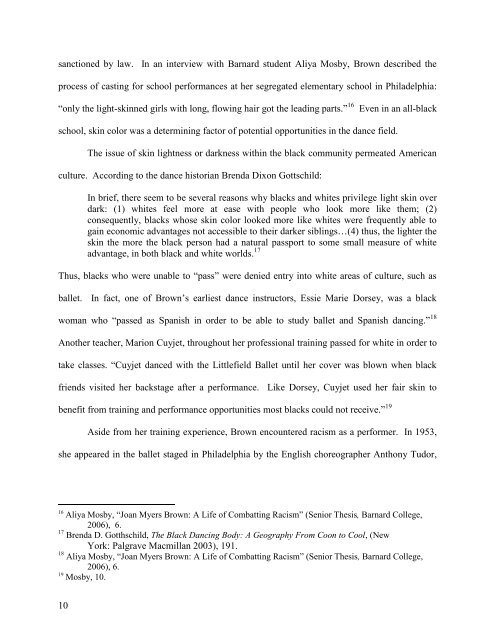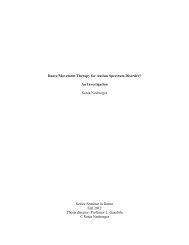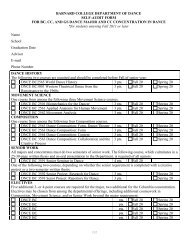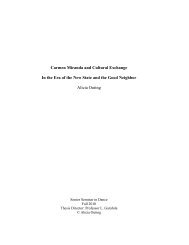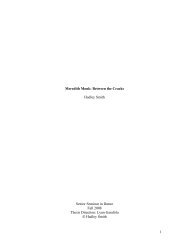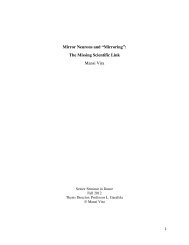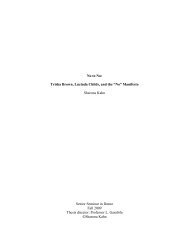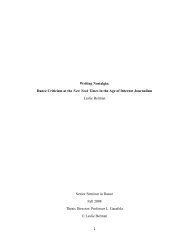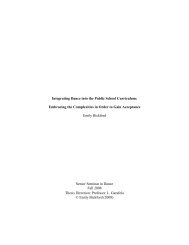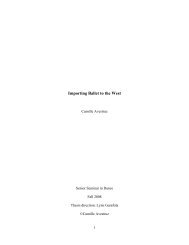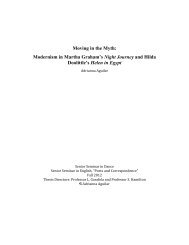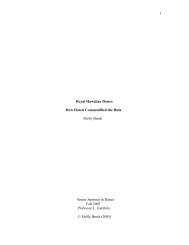Senior Thesis: 5-6 Pages - Dance - Barnard College
Senior Thesis: 5-6 Pages - Dance - Barnard College
Senior Thesis: 5-6 Pages - Dance - Barnard College
Create successful ePaper yourself
Turn your PDF publications into a flip-book with our unique Google optimized e-Paper software.
sanctioned by law. In an interview with <strong>Barnard</strong> student Aliya Mosby, Brown described the<br />
process of casting for school performances at her segregated elementary school in Philadelphia:<br />
“only the light-skinned girls with long, flowing hair got the leading parts.” 16 Even in an all-black<br />
school, skin color was a determining factor of potential opportunities in the dance field.<br />
10<br />
The issue of skin lightness or darkness within the black community permeated American<br />
culture. According to the dance historian Brenda Dixon Gottschild:<br />
In brief, there seem to be several reasons why blacks and whites privilege light skin over<br />
dark: (1) whites feel more at ease with people who look more like them; (2)<br />
consequently, blacks whose skin color looked more like whites were frequently able to<br />
gain economic advantages not accessible to their darker siblings…(4) thus, the lighter the<br />
skin the more the black person had a natural passport to some small measure of white<br />
advantage, in both black and white worlds. 17<br />
Thus, blacks who were unable to “pass” were denied entry into white areas of culture, such as<br />
ballet. In fact, one of Brown’s earliest dance instructors, Essie Marie Dorsey, was a black<br />
woman who “passed as Spanish in order to be able to study ballet and Spanish dancing.” 18<br />
Another teacher, Marion Cuyjet, throughout her professional training passed for white in order to<br />
take classes. “Cuyjet danced with the Littlefield Ballet until her cover was blown when black<br />
friends visited her backstage after a performance. Like Dorsey, Cuyjet used her fair skin to<br />
benefit from training and performance opportunities most blacks could not receive.” 19<br />
Aside from her training experience, Brown encountered racism as a performer. In 1953,<br />
she appeared in the ballet staged in Philadelphia by the English choreographer Anthony Tudor,<br />
16<br />
Aliya Mosby, “Joan Myers Brown: A Life of Combatting Racism” (<strong>Senior</strong> <strong>Thesis</strong>, <strong>Barnard</strong> <strong>College</strong>,<br />
2006), 6.<br />
17<br />
Brenda D. Gotthschild, The Black Dancing Body: A Geography From Coon to Cool, (New<br />
York: Palgrave Macmillan 2003), 191.<br />
18<br />
Aliya Mosby, “Joan Myers Brown: A Life of Combatting Racism” (<strong>Senior</strong> <strong>Thesis</strong>, <strong>Barnard</strong> <strong>College</strong>,<br />
2006), 6.<br />
19 Mosby, 10.


